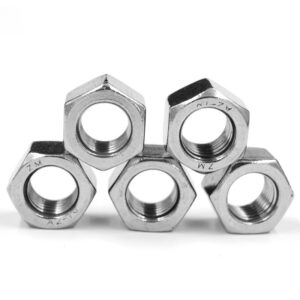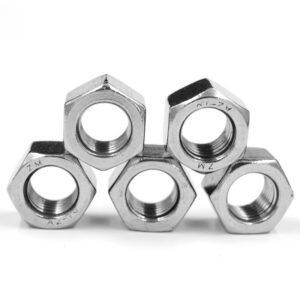HastelloyC-2000(N06200/NS3405/2.4675) nut
Category: Hexagonal nuts
Product grade:A grade
Strength level: Level 8
Width across sides: 8-120
Height: 5.6-60 (mm)
Thread specification: M5-M100
Surface treatment: No treatment
Similar brands
| GB/T | UNS | Trademark | W.Nr |
| NS3405 | N06200 | Hastelloy C-2000 | 2.4675 |
Chemical composition of Hastelloy C-2000 nuts
| Alloy | % | Ni | Cu | Fe | C | Si | S | Cr | Al | Mo | P | Co |
| Hastelloy C-2000 | Min | Balance | 1.3 | – | — | — | — | 22 | — | 15 | — | — |
| Max | 1.9 | 3 | 0.01 | 0.08 | 0.01 | 24 | 0.5 | 17 | 0.025 | 2 |
Physical Properties of Hastelloy C-2000 Nuts
| density | 8.5g/cm3 |
| melting point | 1399°C |
| Thermal conductivity | 10.8 W(M·K) |
| Elastic Modulus | 206 KN/mm2 |
Minimum mechanical properties of the alloy Hastelloy C-2000 nut at room temperature
| Alloy status | tensile strength Rm N/mm2 | Yield Strength RP0.2 N/mm2 | Elongation A5% |
| Solid solution | 690 | 283 | 45 |
Hastelloy C-2000 Nut Features:
Hastelloy C-2000 This alloy is designed to resist more corrosive chemicals, including sulfuric acid, hydrochloric acid, and hydrogen acid. Unlike the previously optimized NI-CR-MO alloy, which can only resist oxidizing or reducing acids, the C-2000 alloy has corrosion resistance in both environments. The combined effect of molybdenum and copper (at levels of 16% and 1.6% respectively) gives the alloy excellent resistance to corrosion by reducing media, while the high chromium content (23% WT) ensures resistance to corrosion by oxidizing media. .
- It is inappropriate to perform post-weld stress relief treatment on NI-CR-MO alloy at approximately 650°C. Generally, heat treatment is not required after welding, but if stress relief is required, it is recommended to perform complete solution annealing at 1149°C and then water quenching.
- The thermal processing temperature range of the alloy is 1080℃-900℃, and the cooling method is water cooling or other rapid cooling methods. In order to ensure the best anti-corrosion performance, solid solution treatment should be carried out after thermal processing.
The metallographic structure of Hastelloy C-2000 nut:
The face-centered cubic lattice structure and its chemical composition ensure metallographic stability and resistance to sensitization.
Corrosion resistance of Hastelloy C-2000 nuts:
Hastelloy C-2000 This alloy is designed to resist more corrosive chemicals, including sulfuric acid, hydrochloric acid, and hydrogen acid. Unlike the previously optimized NI-CR-MO alloy, which can only resist oxidizing or reducing acids, the C-2000 alloy has corrosion resistance in both environments. The combined effect of molybdenum and copper (at levels of 16% and 1.6% respectively) gives the alloy excellent resistance to corrosion by reducing media, while the high chromium content (23% WT) ensures resistance to corrosion by oxidizing media. .
Hastelloy C-2000 Application Scope Application areas include:
Hastelloy C-2000 offers great potential for increased production. When used in the place of the original NI-CR-MO alloy, its enhanced corrosion resistance can lead to longer equipment life under the same material thickness and a higher safety factor under harsher conditions. The improvement in corrosion resistance in all aspects allows the equipment to be used for multiple purposes (reactors, heat exchangers, valves, pumps, etc.), thereby achieving a greater return on investment. For example, a reactor can be adapted to a hydrochloric acid mixture and then converted to another working condition of a nitric acid-based mixture. It is the best nickel-based alloy material that can adapt to a variety of processes.





Reviews
There are no reviews yet.